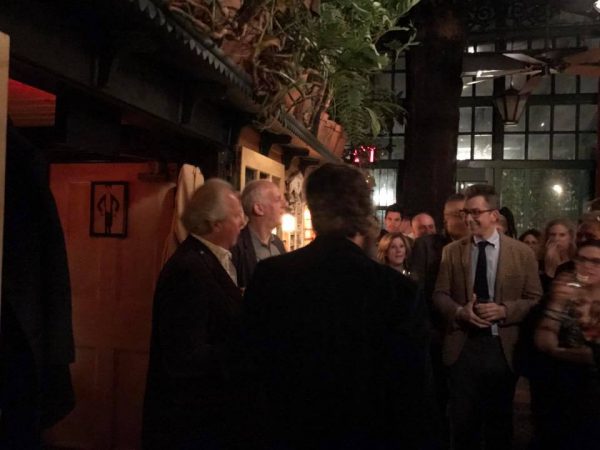 Spy turned thirty this year. Graydon Carter threw a party for the old gang at the Waverly, which I am sorry I missed. Working at the magazine remains my happiest professional experience; still ranks kind of high on my personal experiences as well. Daniel Carter took a couple pictures; Tom Phillips brought T-shirts (I hope I get one); and Susan Morrison shared brought the Wayne Newton recording of `Spy Way’ (lyrics by Joanne Gruber.) Graydon Carter added a nice valediction. “People are often amazed by how simply decent the staff at Spy was—and by decent, I mean fine people,” he said. “What a glorious, talented group and I am so immensely proud of being part of it. How lucky we were.” Yes we were.
Spy turned thirty this year. Graydon Carter threw a party for the old gang at the Waverly, which I am sorry I missed. Working at the magazine remains my happiest professional experience; still ranks kind of high on my personal experiences as well. Daniel Carter took a couple pictures; Tom Phillips brought T-shirts (I hope I get one); and Susan Morrison shared brought the Wayne Newton recording of `Spy Way’ (lyrics by Joanne Gruber.) Graydon Carter added a nice valediction. “People are often amazed by how simply decent the staff at Spy was—and by decent, I mean fine people,” he said. “What a glorious, talented group and I am so immensely proud of being part of it. How lucky we were.” Yes we were.
Also last week, I discovered an interesting review of Spy‘s long and extensive coverage of Donald Trump. Appearing on a site called pando.com, the article by a journalist named Mark Ames really gets us–really, really get us. Says Ames:
SPY was vicious and funny and smart — a fortress/safe zone for all the legions of pissed off, overeducated college grads with literary ambitions and a long list of personal grudges to work off… and bridges to burn. What made each new issue of SPY thrilling to read was the vicious satire—the way they went too far, gratuitously vicious, beyond the point of repetitiveness, to hit some very deserving targets.
 SPY won my heart by relentlessly savaging what passed for the American literati in the Reagan Era: Bret Easton Ellis, Jay McInerney, Tama Janowitz — the triumvirate of the talentless, all that was loathsome, boring, affected and just plain wrong with American prose. . .
SPY won my heart by relentlessly savaging what passed for the American literati in the Reagan Era: Bret Easton Ellis, Jay McInerney, Tama Janowitz — the triumvirate of the talentless, all that was loathsome, boring, affected and just plain wrong with American prose. . .
What affected me most about SPY’s satire was its recklessness and irresponsibility, at least by the stuff-shirt standards of American prose. And even by contemporary standards of what passes for “biting satire” in this country. One of the problems I’ve always had with Jon Stewart and Colbert is the sense you get that they don’t really want to drive the targets of their comedy to ruin and dance on their graves. There’s something a bit too self-consciously responsible about their comedy, however brilliant and talented—a humanitarian, liberal impulse that they can always be friends with the targets of their satire, if they can all make a show of laughing at themselves and not taking themselves too seriously.
You never got the sense that SPY took its targets lightly or saw its satire as all a big joke, ha-ha-ha, we’re all friends at the end of the day bullshit. SPY was serious about its hate, in spite of its somewhat precious prep school surface prose. SPY wanted its loathsome celebrity targets destroyed, not merely roasted. And those who fell were not nobly pitied or helped back up with a gentlemanly hand; SPY shamelessly gloated over their fallen celebrity corpses and dragged them through the magazine’s central squares and back alleyways for all to have a mean vicious laugh at.
Ames proceeds to enthusiastically cover all fifteen rounds of our Trump beat-down, but saves special favor for “the August 1990 issue, SPY’s greatest of all, featuring a bawling oversized Trump head on a child’s body in prep school uniform, with the headline: “WA-A-A-A-H! Little Donald—Unhappy at Last.” In this issue, “SPY managed to both gratuitously drive its satirical stake in Trump’s heart—then pull it out, twist it, drive it in again, and wiggle it around.” The “coup de grace: an eight-page spread of fake newspaper clippings from a time machine, tracing the sad decline and disgrace of Donald Trump from 1990 – 1996. Headlined “A Casino Too Far: Pages from the Donald J. Trump Scrapbook, 1990-96,” it stands as quite possibly the funniest and most savage eight pages of satire ever put to glossy print in this country.” Later, he calls it “the high-water mark for SPY, and for American satirical journalism.” Shucks, Mark–I’m glad you liked it.
